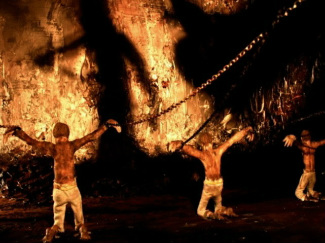 Scene from "The Cave: An Adaptation of Plato’s Allegory in Clay" Tags: knowledge, social construction, theory, allegory of the cave, karl mannheim, peter berger, plato, social construction of reality, thomas luckmann, 00 to 05 mins Year: 2007 Length: 3:11 Access: YouTube Summary: This award-winning short claymation film is an adaptation of Plato's Allegory of the Cave and can be used to teach core concepts from the sociology of knowledge, including the social construction of reality. The Allegory of the Cave, presented in Plato's Republic, tells the story of prisoners trapped in a cave who can only see shadows casted on the wall in front of them. Plato's story is a commentary on the human condition, in which he suggests that humans are trapped in a material world, interpreting illusions and shadows to be reality. Plato's theory shares similarities with ideas presented in Berger and Luckmann's (1966) The Social Construction of Reality, specifically that our perception of reality is shaped by our social and physical location. In this way, reality is not absolute, and what we understand to be "real" is actually a social construct. To deepen the discussion, instructors might also screen or assign the following two instructional videos: the first provides details about Plato's Allegory of the Cave and the second explains Plato's Theory of Forms. As shown in the first video, when one of the prisoners is exposed to the sun of the outside world, Plato believes he no longer inhabits a world of illusions and shadows. Similar to the abilities of the philosopher, the prisoner can now see the world for what it is. Instructors can distinguish this feature of Plato's Allegory from Berger and Luckmann's theory, highlighting that Berger and Luckmann would contest this point, as there is no one reality. Similar to the relativist critique of Plato's Theory of Forms (discussed here at minute mark 2:09), a social constructionist perspective argues that reality is based on social agreement, and does not exist outside of the mind. These clips can be used to teach other ideas from the sociology of knowledge, such as Mannheim's (1929) argument about the role of intellectuals in society, presented in Ideology and Utopia. Instructors can compare and contrast Mannheim's arguments to Plato's claim that, because of their privileged ability to see the world for what it "really" is, philosophers are best positioned to rule society (discussed here at minute mark 6:55). To learn more about this clay animation film, how it was made, and the awards it has won, click here. Submitted By: Murali Shanmugavelan
2 Comments
Manuel Franco
7/30/2023 11:42:08 am
I just want to say Thank You to everyone who supported me through the years. My name is Manuel Franco, New Berlin, Wisconsin. My story of how I won the Powerball lottery of $768.4M is a bit of a tale. I have been playing Powerball tickets for 6 years now since I turned 18. I bought my first ticket on my 18 birthday. I was feeling very lucky that day because I had contacted Dr. Odunga Michael to help me with the winning Powerball numbers. I really had that great great feeling that I looked at the camera wanting to wink at it. I only did a tiny part of it and trusted him. He gave me the numbers after I played a couple other tickets along with it for $10. I checked my ticket after the winnings came online and saw the numbers were correct including the Power play. I screamed for about 10 minutes because it felt like a dream. I had won $768.4M. You can check my winning testimony with the lottery officials just with my name search. Thank you Dr Odunga. Well, his email is [email protected] and you can also call or Whats-app him at +2348167159012 so you guys can contact him
Reply
mark hold
7/8/2024 07:26:39 am
Herbal Penis Enlargement product is 100% guaranteed to Enlarge and get a better ERECTION, the reason why most people are finding it difficult to enlarge Penis is that they believe in medical reports, drugs and medical treatment which is not helpful for Penis Enlargement. Natural roots/herbs are the best remedies which can easily Enlarge your Penis permanently Contact Dr MOSES BUBA via Email: [email protected] or via WhatsApp: +2349060529305. for Natural root and herbal remedies put together to help Enlarge manhood and Erect healthily. I also learn that Dr MOSES BUBA also can cure other types of diseases, HEPATITIS B,DIABETICS,CANCER,HPV,LOW SPERM CAM, HIV/STDS, FIBROSIS LOST OF WEIGHT, BREAST ENLARGEMENT, HIPS and BUMS ENLARGEMENT etc .
Reply
Leave a Reply. |
Tags
All
.
Got any videos?
Are you finding useful videos for your classes? Do you have good videos you use in your own classes? Please consider submitting your videos here and helping us build our database!
|
 RSS Feed
RSS Feed
